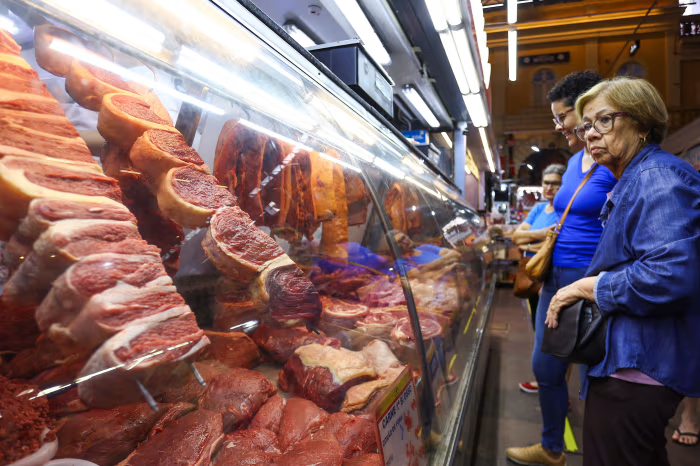Food is a basic need, yet for many around the world, putting a meal on the table is becoming more expensive. According to the latest global data, food prices rose in June, primarily due to a significant increase in the prices of meat and vegetable oils. These changes are affecting consumers, food producers, and economies globally, making this a growing concern for both policymakers and everyday shoppers.
In this article, we’ll explore the reasons behind this price surge, how it affects various countries, what it means for consumers, and what experts believe might happen next.
Why Food Prices Rose in June
The Food and Agriculture Organization (FAO) of the United Nations reported that food prices rose in June by 2.1% compared to May 2025. The increase was led mainly by meat and vegetable oils, with other food groups showing mixed trends.
Here’s a breakdown of the key reasons:
- Meat Prices Surge: Global meat prices jumped due to higher demand, especially from countries like China and the Middle East. Rising feed costs and animal disease outbreaks also disrupted supply chains.
- Vegetable Oil Prices Climb: Vegetable oils, particularly sunflower and palm oil, saw significant price increases. This was due to tight supplies from major exporters like Indonesia and Ukraine, along with strong demand from biodiesel producers.
- Climate and Weather Factors: Droughts in parts of Africa, Southeast Asia, and South America have impacted crop yields. Lower production of soybeans and palm oil affected the availability of vegetable oils.
- Geopolitical Unrest: Conflicts in exporting countries and trade restrictions are creating supply shortages, leading to price hikes across various commodities.
Rising Meat Prices: What’s Driving It?
One of the main contributors to why food prices rose in June is the surge in global meat prices. Here’s what’s causing the upward trend:
1. Higher Demand from Growing Economies
Countries with expanding middle classes, like China, India, and the Gulf nations, are increasing their consumption of beef, poultry, and pork. This puts pressure on the global supply.
2. Feed Prices Are Up
The cost of animal feed has risen, mainly due to higher corn and soybean prices. When it costs more to feed livestock, meat prices go up.
3. Disease Outbreaks
Avian flu and swine fever have hit livestock populations in several countries. Reduced supply leads to increased prices.
4. Export Restrictions
Some countries, facing domestic shortages, have limited meat exports to protect their own markets, further squeezing international supply.
Vegetable Oil Prices Soar: A Closer Look
Vegetable oils are used in cooking, food production, and even cosmetics and biofuel. When their prices go up, it affects a wide range of products.
1. Declining Production
Key producers like Indonesia (palm oil) and Ukraine (sunflower oil) have seen lower output due to weather issues and political unrest.
2. Export Policies
Indonesia briefly banned palm oil exports earlier this year to stabilize domestic prices. Even temporary bans cause global uncertainty and price spikes.
3. Alternative Fuel Demand
There’s a growing use of vegetable oils in biodiesel production. As countries push for cleaner energy, food-grade oils are being diverted, reducing supply for food use.
Global Impact of Rising Food Prices
The effects of the recent spike are being felt differently across regions. While wealthier nations can absorb higher costs, low-income and developing countries are under serious pressure.
In Developed Countries:
- Grocery bills are increasing
- Restaurants are raising menu prices
- Consumers are switching to cheaper food options
In Developing Countries:
- Families are reducing portion sizes or skipping meals
- Nutrition levels are falling as people avoid costlier proteins
- Governments are increasing food subsidies to prevent hunger
How It Affects Your Wallet

Whether you’re a shopper in New York, Mumbai, or Nairobi, food prices rising in June means more money spent at the store. Here’s how consumers are adapting:
- Switching Brands: Shoppers are choosing store brands or generics instead of premium products
- Buying in Bulk: Households are buying larger quantities to save money over time
- Reducing Meat Consumption: Some families are replacing meat with legumes, eggs, or plant-based proteins
- Meal Planning: More people are planning meals in advance to reduce waste and cost
What About Other Food Groups?
While meat and vegetable oils led the price increases, other categories showed mixed results:
- Dairy Prices: Slightly down due to steady milk production in Europe and North America
- Cereal Prices: Stable overall, though rice prices rose slightly
- Sugar Prices: Remained high, mainly due to dry weather in Brazil affecting cane harvests
What Experts Say About the Future
Economists and agriculture experts are keeping a close eye on the food price trends. Here’s what they suggest could happen next:
Short-Term Outlook:
- Prices might remain high in July and August due to continuing weather issues and geopolitical uncertainty
- Export restrictions and panic buying could make things worse
Long-Term Possibilities:
- If oil prices stabilize and weather conditions improve, food prices might come down slightly by the end of the year
- Innovation in agriculture and better trade deals could help reduce volatility
What Governments and Organizations Are Doing
To control the rising food prices, many governments and global organizations are stepping in:
- Import Tariff Cuts: Some countries are reducing taxes on imported food to make them more affordable
- Subsidies: Financial aid is being given to farmers and low-income families
- Stockpiling: Governments are increasing their food reserves to deal with future shortages
- Monitoring and Regulation: International bodies like the FAO and World Bank are closely tracking food price trends and recommending policy responses
Tips to Cope with Rising Food Prices
If you’re struggling with higher grocery bills, here are some practical tips:
- Shop with a List: Avoid impulse buys and stick to essential items
- Buy Seasonal Produce: Fruits and vegetables in season are usually cheaper and fresher
- Try Meatless Meals: Plan meals that use beans, lentils, or tofu instead of meat
- Compare Prices: Use apps or check flyers to find the best deals in your area
- Store Food Properly: Avoid waste by storing food correctly to keep it fresh longer
Final Thoughts
There’s no denying that food prices rose in June, creating financial pressure on millions across the globe. Meat and vegetable oils were the main culprits behind this surge, and while the situation is being closely monitored, relief may take some time.
Whether you’re a policymaker, a food business owner, or just someone trying to budget better, it’s important to stay informed and adaptable. The global food system is complex, and changes in one part of the world can affect prices everywhere.
For now, planning wisely, reducing waste, and making smart choices at the grocery store are some of the best ways to manage through this period of food inflation.
Read Next – Economic Impact of Government Bill: Boost Now, Risks Ahead





